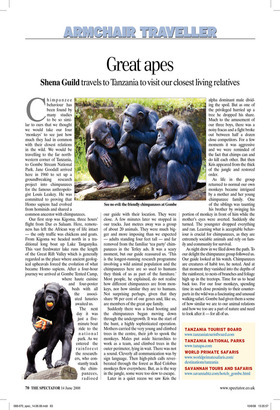Great apes
Shena Guild travels to Tanzania to visit our closest living relatives Ch i m p a n z e e behaviour has been found by many studies to be so similar to ours that we thought we would take our four ‘monkeys’ to see just how much they had in common with their closest relations in the wild. We would be travelling to the far northwestern corner of Tanzania, to Gombe Stream National Park. Jane Goodall arrived here in 1960 to set up a groundbreaking research project into chimpanzees for the famous anthropologist Louis Leakey. He was committed to proving that Homo sapiens had evolved from hominids and shared a common ancestor with chimpanzees. Our first stop was Kigoma, three hours’ flight from Dar es Salaam. Here, remoteness has left the African way of life intact — the only traffic was chickens and goats. From Kigoma we headed north in a traditional long boat up Lake Tanganyika. This vast freshwater lake runs the length of the Great Rift Valley which is generally regarded as the place where ancient geological upheavals forced the evolution of what became Homo sapiens. After a four-hour journey we arrived at Gombe Tented Camp, where haute cuisine and four-poster beds with all the associated luxuries awaited us. The next day it was just a fiveminute boat ride to the national park. As we entered the rainforest the researchers, who constantly track the chimpanzees, radioed our guide with their location. They were close. A few minutes later we stopped in our tracks. Just metres away was a group of about 20 animals. They were much bigger and more imposing than we expected — adults standing four feet tall — and far removed from the familiar ‘tea party’ chimpanzees in the Tetley ads. It was a scary moment, but our guide reassured us. ‘This is the longest-running research programme involving a wild animal population and the chimpanzees here are so used to humans they think of us as part of the furniture.’ Most people, he explained, do not realise how different chimpanzees are from monkeys, nor how similar they are to humans. Not surprising perhaps, given that they share 98 per cent of our genes and, like us, are members of the great ape family.
Suddenly there was a loud hooting and the chimpanzees began moving down through the undergrowth. It was the start of the hunt, a highly sophisticated operation. Mothers carried the very young and climbed trees in the centre, their job to spook the monkeys. Males put aside hierarchies to work as a team, and climbed trees in the outer perimeter, lying in wait. There was not a sound. Cleverly all communication was by sign language. Then high-pitch calls reverberated through the forest as Red Colobus monkeys flew everywhere. But, as is the way in the jungle, some were too slow to escape.
Later in a quiet recess we saw Kris the alpha dominant male dividing the spoil. But as one of the privileged hurried up a tree he dropped his share. Much to the amusement of our three boys, there was a noisy fracas and a fight broke out between half a dozen close competitors. For a few moments it was aggressive and we were reminded of the fact that chimps can and do kill each other. But then Kris appeared from the thick of the jungle and restored order.
As life in the group returned to normal our own monkeys became intrigued by a mother and her young chimpanzee family. One of the siblings was taunting his brother by swinging his portion of monkey in front of him while the mother’s eyes were averted. Suddenly she turned. The youngster dropped everything and ran. Learning what is acceptable behaviour is crucial for chimpanzees, as they are extremely sociable animals and rely on family and community for survival.
As night drew in we filed down the path. To our delight the chimpanzee group followed us. Our guide looked at his watch. Chimpanzees are creatures of habit too, he noted. And at that moment they vanished into the depths of the rainforest, to nests of branches and foliage high up in the treetops. Time for us to head back too. For our four monkeys, spending time in such close proximity to their counterparts in the wild was a fascinating and unusual walking safari. Gombe had given them a sense of how similar we are to our animal relations and how we too are a part of nature and need to look after it — for all of us.


















































































 Previous page
Previous page